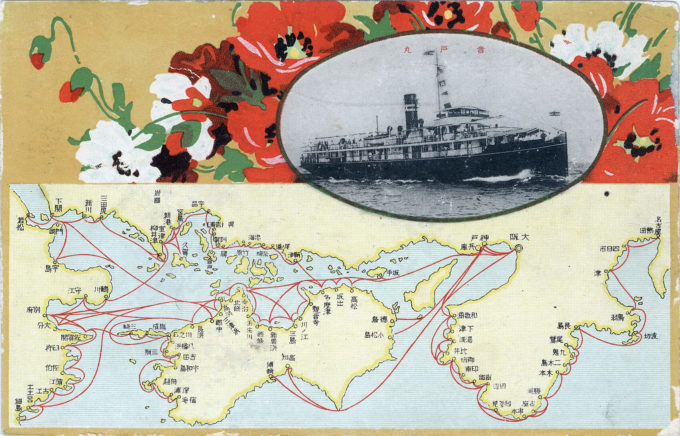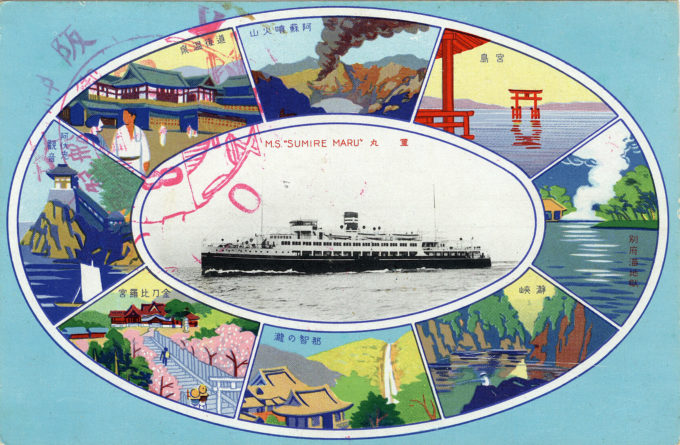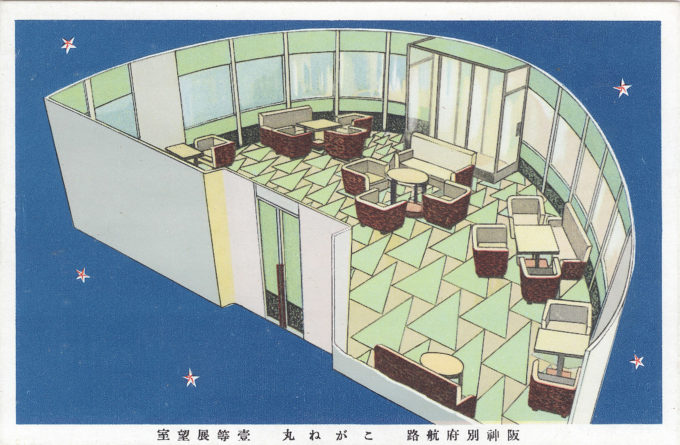
M.S. Oto-maru (inset photo), Seto Inland Sea routes, O.S.K. Lines, c. 1930. The Ota-maru was launched in 1924 as the lead ship (of three) of Osaka Shosen’s first class of diesel-fueled passenger-cargo liners. one of the earliest in Japan placed into regular service. Passenger accommodations included second-class cabins on the upper deck; third-class cabins located on the middle deck in the stern. After sailing with O.S.K. for 15 years, the Ota-maru was sold in 1940 to a Chinese shipping company, after which its whereabouts are unknown.
The Ota-maru-class of liners were unique in more than one aspect. Because diesel exhaust did not require a large funnel (as did coal-fueled vessels), the ship was originally launched sporting only a narrow chimney. This did not allow for the display of the O.S.K. livery (two white stripes), so a steamer-type dummy funnel was soon installed.
See also:
“Principal services of OSK Line”, Osaka Shosen Kaisha, c. 1930.
“The most beautiful scenic view in Japan is the Inland Sea, which is sometimes called the ‘Mediterranean of Japan’. Extending 240 miles from Kobe on the east to Shimonoseki on the west, its widest part is only 40 miles, while the narrowest place hardly permits two ships to pass. In this inland water are thousands of small islands.
“The west bound ship, in about thirty minutes after leaving Kobe, passes through the Akashi channel, the eastern gateway of the Inland Sea. On the starboard side are delightful views of the white sandy beaches and green pine trees at Suma, Maiko, and Akashi, and on the port side are the beauties of Awaji Island. These sights have inspired the fancies of poets throughout the ages.
“… Tourists from Europe and America make a point of making a special trip through the Insland Sea. On the big ocean liners, there is no possibility of seeing the romantic views of the small islets and bays, so the O.S.K. has specially arranged excellent boats which run near the shores of the Inland Sea. It is almost equal to enjoying the scenic beauty in one’s own private yacht. Persons intending to take a trip from Osaka to Kyushu, or further, may thus enjoy this scenic route, at the same time being more comfortable than on the overland route.
“In and about the Inland Sea, the O.S.K. has over ten lines, with some thirty ships. Among these the Osaka-Sanyo line, Osaka-Miyajima line (except in winter), and Osaka-Tadotsu line use modern high class passenger ships, of which the company may well be proud.”
– O.S.K. travel brochure, ca. 1930

M.S. Sumire Maru, O.S.K. Lines Inland Sea Service, c. 1930, surrounded by illustrations depicting several Inland Sea Service destinations. Clockwise from the top: Mt. Aso volcano, Kumamoto Prefecture; Ise Shrine, Miyajima, Hiroshima Prefecture; Beppu hot springs, Oita Prefecture; Doro Gorge, Wakayama Prefecture; Nachi Falls, Wakayama Prefecture; Kotohira Shrine, Kagawa Prefecture; Bandai Temple, Hiroshima Prefecture; Dogo Onsen, Ehime Prefecture.
Osaka Shosen Kaisha (O.S.K.) was founded in 1884 when 55 ship owners, each of whom had only a small number of vessels, combined their operations. The chief representative of these ship owners was Hirose Saihei, senior manager of the Sumitomo zaibatsu (conglomerate) and a prominent figure in Osaka financial circles.
In its first few years of operation, O.S.K.’s routes were limited to coastal services in the western area of Japan. In 1890, O.S.K. inaugurated an Osaka-Pusan run followed in 1893 by the operation of an Osaka-Incheon route and Korean coastal services.
Its first trans-oceanic service, a Hong Kong to Tacoma, Washington route, began in 1908. In 1918, the company opened a Bombay to Marseilles route. Subsequently, O.S.K. began operating a San Francisco route, an Australia route, and a South America route, offering a worldwide liner service.
During the Great Depression, O.S.K. and N.Y.K. made a cooperative agreement in 1931 whereby OSK abolished its Puget Sound route, which had called at Tacoma and Seattle, and in turn acquired a monopoly on the South American coast route.



Pingback: “Principal services of O.S.K. Line”, Osaka Shosen Kaisha, c. 1930. | Old TokyoOld Tokyo